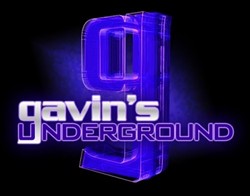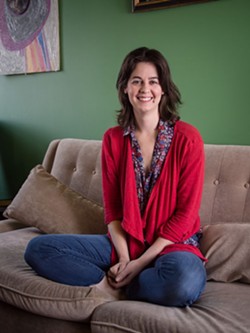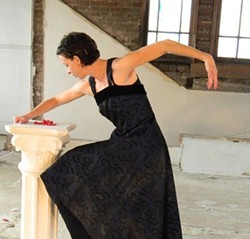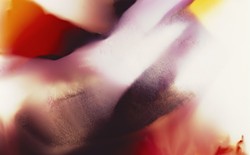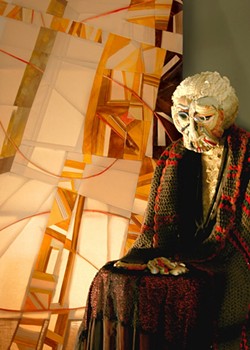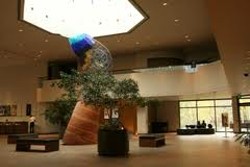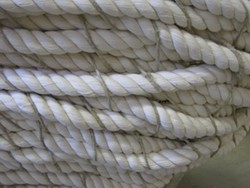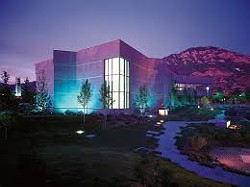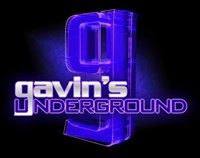Thursday, May 16, 2013
Provo Sites: Work To Do
Posted By Gavin Sheehan on May 16, 2013, 7:00 PM
Out of the frustration of having tons of talent and few venues to display it in, three local dance choreographers have come together to form an organization in Utah County to give these talented individuals a new venue. --- Provo Sites is comprised of Ashley Anderson from loveDANCEmore, as well as Kate Monson and Kori Wakamatsu from the Brigham Young University dance department, who will all be working with the BYU Museum Of Art to showcase a series of performances during their Work To Do exhibition. This will feature four women artists from around the state, tackling the topic of women's work and gender roles in society, which have been featured heavily in Utah media lately. Today, I chat with all three women from Provo Sites about their group and the upcoming exhibition. (Pictures provided by Provo Sites.)
Ashley Anderson, Kori Wakamatsu & Kate Monson
Gavin: Hey, everyone. First thing, tell us a little bit about yourselves.
Ashley: I’m a choreographer based in Salt Lake City. I relocated here in 2009 to share my choreography and teaching, as well as to develop the loveDANCEmore community project.
Kate: I teach part-time at Utah Valley University and BYU. And I drum up other projects whenever I can; for instance, for the past couple of years, I’ve been developing a conditioning program specifically for dancers with Amy Markgraf Jacobsen, a colleague at UVU, and have recently became a member of the Orem Arts Council.
Kori: I am a dance educator and teach at BYU. I am a past public educator and advocate for dance in the K-12 schools. I enjoy collaborative and atypical dance endeavors like Provo Sites. One of the projects I was fortunate enough to work on is Thought Of You, a dance and animation project, with Ryan Woodward. Together, with the support of loveDANCEmore, we co-produce the Provo Sites series, which brings dance to unique venues in the valley. Last fall, we presented at the Historic Provo 4th Ward Building, and this Friday have a show in conjunction with the opening of “Work To Do” at the BYU Museum of Art.
Gavin: Ashley, last time we spoke was for loveDANCEmore. How has the organization been doing lately?
Ashley: loveDANCEmore is growing; as the community-events branch of my 501c3 Ashley Anderson Dances, we’re more eligible for grants each year. This has helped to present numerous works of SLC’s independent choreographers, as well as the Provo Sites project.
Gavin: How did this previous season treat you, and what can we look forward to seeing in '13-'14?
Ashley: Our 2012 report can be found here and it shows that loveDANCEmore ,along with Ashley Anderson Dances, presented over 25 new dances, along with two new performance journals and media screenings representing 16 global artists. In 2013, we’ve had a gallery show at the Rio Grande Depot, the Mudson works-in-progress series and have more on the horizon. In addition to Provo Sites at BYU this May, there will be subsequent concerts at the Central Utah Gardens and Downtown Provo venues, as well as the second-annual Daughters of Mudson in June and a performance for the Utah Heritage Foundation Cultural Series in September. Independently, I’ve been excited to present my work in new formats, like the 35x35 show at Finch Lane Gallery, the Nashville Review, the Swedish Dance History and as a keynote speaker for the Salt Lake Community College Writing and Social Justice Conference. As a small, cooperative model for projects, we pop up with a lot, and the best way to see what’s up is to subscribe on www.lovedancemore.org.
Gavin: Kate and Kori, how did each of you take an interest in art, specifically dance?
Kate: I grew up in a family that was invested in art; I was exposed to, and given lessons in, many forms of art as I grew up. When I went to college, I had the reverse experience of many of my students; I felt like I should look into majoring in something “practical,” but my parents really pushed me to stay in the arts. I chose dance because it was the art form that most inspired me. I enjoyed a lot of other art forms but quickly realized dance was the only one that I looked forward to spending hours a day doing.
Kori: Well ... after seeing The Nutcracker on television as a young girl, I took it upon myself to walk around the house with my toes curled under, a poor attempt at dancing en pointe. My mother was worried that I would permanently damage my feet so she took me to the doctor. He told her there was no permanent damage, not to fret, and to simply get me into some dance lessons. She followed his advice and I have been dancing ever since. Perhaps more importantly than what got me started, though, is what kept me dancing -- the fusion of physical refinement, aesthetics, and creativity are what constantly intrigue me about the dance discipline.
Gavin: What was it like growing up dancing and pursuing it as a career?
Kate: We can all agree that dance has always been rewarding to us; whether physically, intellectually, emotionally or spiritually. Dance is a form that doesn’t always give a lot back monetarily and yet we’ve dedicated our lives to these pursuits. In our careers, we’ve each chosen different paths, but most involve some aspect of education and creative ways, like this show, to keep new choreography part of the Utah dance landscape.
Gavin: What made each of you decide to go into education, and what made you choose BYU and UVU, respectively?
Kori: Like many people, I am often surprised that I have ended up where I am today. I have been determined to keep dance as part of my life and I have always enjoyed teaching. I am fortunate enough to have a career that allows me to merge those two significant components of my life. I think I chose education because I believe in the power of knowledge and the importance of expanding perspectives. I don’t think I would say that I “chose” BYU exactly, but it has been a great place to work and I have learned an incredible amount in my time there. Admittedly, part of me yearns to go back to the K-12 setting, but I wouldn’t trade my years at BYU for anything -- it is an amazing institute of learning, even for the faculty.
Kate: After getting an MFA from Ohio State, I didn’t really know what exactly I planned to do with dance. I had an interest in starting a small pick-up company and then eventually teaching at a university, but just weeks after I graduated, I got a call out of the blue from a university in Ohio that offered me a part-time job and I found that I really loved teaching; that’s pretty much how it has gone ever since. When my husband got a job at BYU, we returned to Utah, and the great people at UVU almost immediately called me up, and then BYU, a couple of years later, did the same, I’ve been extremely blessed and have loved teaching at every college I’ve had an opportunity to be at. That being said, I am at a time in my life that I feel the need to make more proactive artistic decisions about my career and creating Provo Sites with Ashley and Kori has been a large part of that.
Gavin: How is it for both of you working at college dance programs and with students looking to perform professionally?
Kate Monson: Dance is at a transitory place right now. Very few dancers become traditional professional dancers within a company. Educators have a larger responsibility to give a broader base of knowledge and experience to dance students so that they can see that their creativity and ability to think out of the box is just as important to their success as a dancer as having great technical skills. That is part of the mission of Provo Sites, to help the community and our students to see how dance can make a broader mark than what they have traditionally considered.
Kori: It is challenging. Not just because students want to perform professionally, but students want and need expansive experience in dance, and they all have different goals and aspirations. Our students are savvy -- they know that not everyone’s path will lead them to performing with a big-name company. Of course, some want to perform professionally, yet others want to teach, and others want to stay involved as freelance artists. To accomplish this, they need experience in choreography, teaching, production, marketing, critical analysis, and collaboration, just to mention a few. I think that is partly what has motivated Provo Sites -- providing the opportunity for dance professionals, alumni, students, and dance enthusiasts an opportunity to experience dance in a dynamic way. Provo Sites encourages people to expand their view of dance and involve the community by converting any space into a dance space.
Gavin: When did all of you meet, and what have you worked on together prior to this exhibition?
Ashley: We are all familiar to one another from the dance community. We got to talking about what loveDANCEmore was doing in Salt Lake with works-in-progress series and site-specific work and whether similar opportunities would be helpful to keep new choreography happening in Orem and Provo outside of the university setting.
Kate: Surprisingly, one of the hardest things to establish for Provo Sites is the venue. We hope this is something that will become less arduous as we continue. We spent last summer looking for a space all over Utah Valley. Pretty early on, we looked into the Historic Provo 4th Ward building in downtown Provo. It is a beautiful building with stained-glass windows and kind of a kooky layout. By peeking through the windows, we could see that the chapel area had been gutted, leaving it completely open, perfect for some dancing. We got hold of the owner, Greg Soter, who was enthusiastic about our idea but had planned to frame out the space for apartments in July. July was too soon for us, but then his plans got delayed, then our plans got delayed and then finally we committed to doing our inaugural concert in this beautiful empty building on Nov. 12, 2012. We hoped for the best weather and got the worst -- it was the first real snowstorm that week. The building was freezing. We brought in hot chocolate, hand warmers, and blankets, fully expecting to have only our most dedicated family members show up, and were thrilled to fill not only all of the 50 seats we had set up but had people standing in the back and sitting in the front for both performances. We presented amazing works by Ashley, Kori, Nathan Balser, Aaron Shaw and Doris Trujillo. It was such a great adventure in the end that we definitely wanted to keep it going ... but not until the spring.
Gavin: How did the idea of Work To Do come about?
Ashley: After the first successful concert at the Historic Provo 4th Ward building we wanted to keep the momentum going. We brainstormed new settings and discovered that the Work To Do exhibition was coming to the Museum of Art. As women artists working in dance, which is predominantly practiced by women, we thought it would be a good fit for our next concert.
Gavin: Going into this, what are each of your thoughts on gender politics in Utah and the affect it has on the way our state is both governed and represented?
Ashley: I think that gender politics in Utah is not really that different than elsewhere in the United States, although it is often magnified by the context of a religious majority. What’s more interesting than that is Utah’s support of the arts, which are frequently anchored by strong women. To see BYU acknowledge the importance of highlighting women visual artists and sharing the work of women choreographers is as much about acknowledging who is making art here as it is about “gender politics” per se.
Kori: I think Ashley is right. I don’t see gender politics as being that dramatically different in Utah -- except that we might perceive it as so. What I see as one of the most important gender issues around the world -- not just in Utah -- is that women are often perceived as “less than.” I detest the devaluation of women. I believe in the power of womanhood and the ability for one woman to make a difference. I believe that for men, as well. But as a woman and an artist, both of which are arguably marginalized, I find myself constantly promoting the empowerment of women and the merit of the arts.
Kate: I think I am more in touch with gender politics in the arts and especially dance. In dance, the wide majority of choreographers and dancers are women and yet the majority of money and recognition goes to male choreographers, dancers, and artistic directors. I am always surprised and dismayed by this disparity. I would imagine that this is also true to a degree in the visual arts, so I was excited to see and be a part of an exhibit that clearly celebrated women artists.
Gavin: What was the process in selecting the four artists and choreographers being showcased, and what was it about each one that made them stand out?
Kori: Provo Sites choreographers are selected by open application and, as working women artists, were a good fit for the Work To Do site. Angela Banchero-Kelleher has been living and working in Utah for a long time, both as an educator for UVU and performer for companies including RDT. Her presence is matched by the energy of new choreographers and valley educators, Shayla Bott and Joni Tuttle. Shayla, BYU ballet faculty, is a rising choreographer and has received recent acclaim at Seattle’s Chop Shop Dance Festival and the American College Dance Festival, Northwest Region. Joni, formerly of Northwest Dance Project, is also an up-and-coming Utah dance artist and newly named assistant director of BYU’s Contemporary Dance Theatre. As co-producers, we also like to keep our hand in and Ashley made a trio for all of us that utilizes female powerhouse vocalists Barbra Streisand and Judy Garland. Each of these women offer a different physical point of view.
Gavin: Considering the content and the theme of the exhibition itself, how important is it for this to happen at BYU rather than at a bigger or more prominent gallery in the state?
Kori: BYU’s Museum of Art is one of the most highly attended university museums in the Mountain West, and many of the guests are not from the student body. So, I think it is an important message to send not only to the on-campus students, but to the larger community: Women’s work is important. I think the audience will be pleased by the choice of artwork and content; it’s surprising and eclectic. I don’t think this is necessarily a “rather than” question, but more of a “wow, I’m glad this exhibit is happening so we can talk about these important issues.” I think that is the poignancy of art: that it allows us to feel, sense, respond, ponder. The mission of the Museum of Art perhaps explains it best: “We hope your experience ... will nurture a reflective mind, a capacity for deeper inquiry, a stronger commitment to excellence and integrity, and heightened appreciation for others and their ideas.” If you join us that evening, I think you will have this kind of experience.
Gavin: Of the four artists involved, who's work do you like the most and why?
Kate: The works by Trent Alvey and Pam Bowman both made a strong impression on me; I think because there was something tactile about their pieces and they also made abstract but editorial statements about the unique culture of Utah and especially Utah Valley. They were inspiring to many of the choreographers participating.
Gavin: What are you hoping people will take away from this exhibition and the message itself?
Kate: We hope this isn’t too simple, but with all of the Provo Sites projects we simply hope people leave excited about art, remembering how it makes them think and feel about being human. If they get a specific message or social statement that helps make sense of the world around them, then that’s fantastic, too. In this case, we also hope the audience finds satisfaction in viewing the juxtaposition of our choreography with these incredible visual artists.
Gavin: What can we expect from Provo Sites over the rest of the year?
Ashley: We are planning shows for summer 2013 at the Central Utah Gardens, and fall 2013 at downtown Provo venues. If you subscribe on the website, you will get all the details on upcoming shows, as well as any other loveDANCEmore events.
Gavin: How long does the overall exhibition run?
Kori: While we are only performing as part of the gallery opening, the visual art in the exhibition will be open from May 17-Sept. 28. You can see works by Trent Alvey, Pam Bowman, Jann Haworth and Amy Jorgensen. For details on their work and curatorial mission, visit the museum's website. We are thrilled that highlighting dance was considered an important mission in relationship to this exhibition, and encourage anyone to go see their creative work.
Gavin: Aside from the obvious, is there anything you'd like to promote or plug?
Kate: Most of our upcoming events are included above, but we can reiterate that as independent artists we often pick up projects on a rolling basis rather than retaining a season at one venue. The best way to follow that is to check our website.
| Follow Gavin's Underground: |
On Topic...
-
Film Reviews: New Releases for April 19
The Ministry of Ungentlemanly Warfare, Abigail, The Beast, Hard Miles, Sasquatch Sunset and more
- Apr 19, 2024
-
Film Reviews: New Releases for April 12
Civil War, Escape from Germany, Coup de Chance, Hundreds of Beavers, La Chimera, Sting
- Apr 11, 2024
-
Film Reviews: New Releases for April 5
Monkey Man, The First Omen, Wicked Little Letters, Girls State, Scoop, Exhuma
- Apr 4, 2024
- More Gavin's Underground » More Culture »
More by Gavin Sheehan
-
Gavin's Underground: End Of An Era
Nine and a half years of local entertainment blogging comes to an end.
- May 26, 2017
-
Torris Fairley
A quick interview with the up-and-coming SLC-based comedian.
- May 25, 2017
-
Cirque Asylum
A look into the dance school teaching unique forms of aerial arts.
- May 24, 2017
- More »


